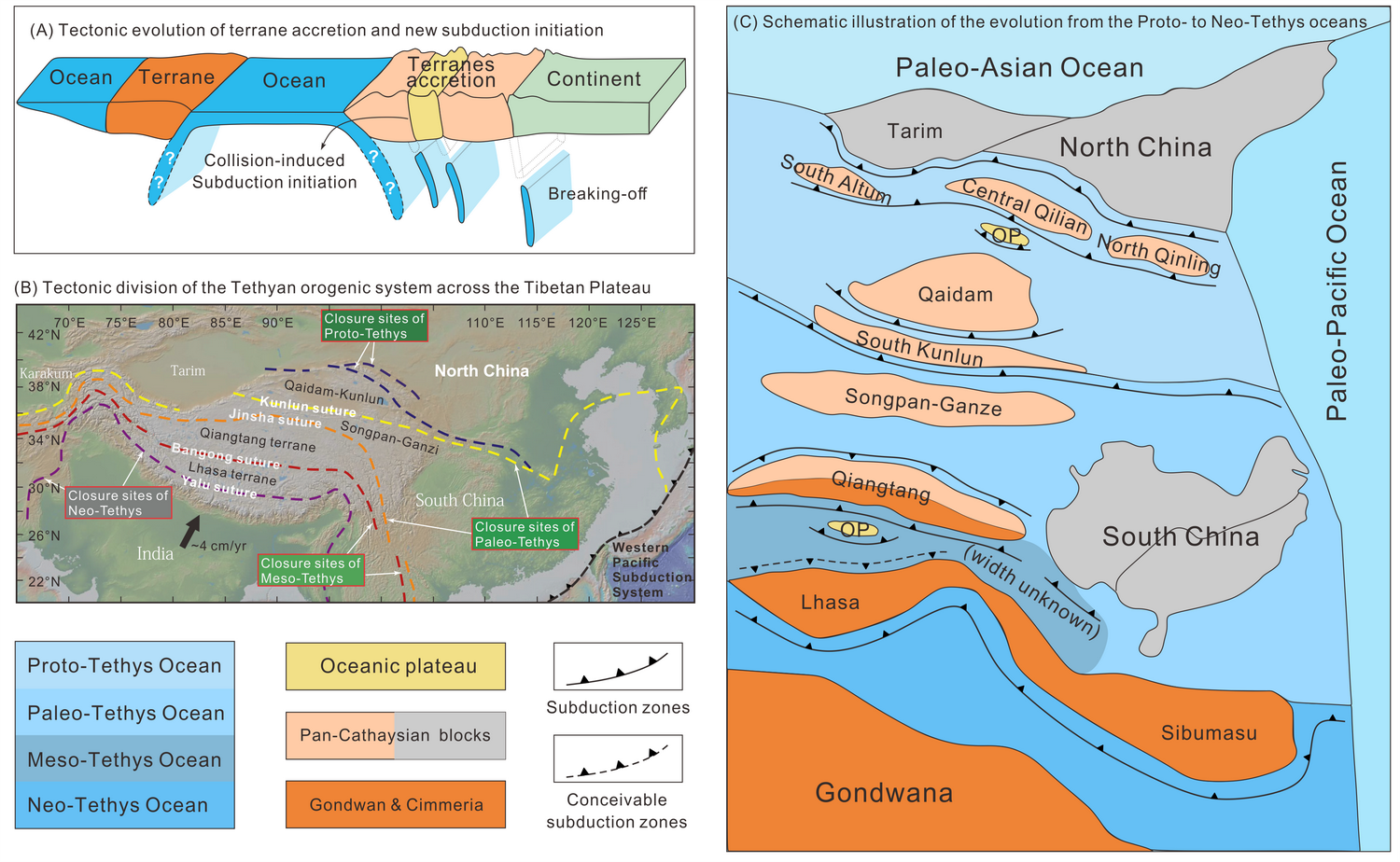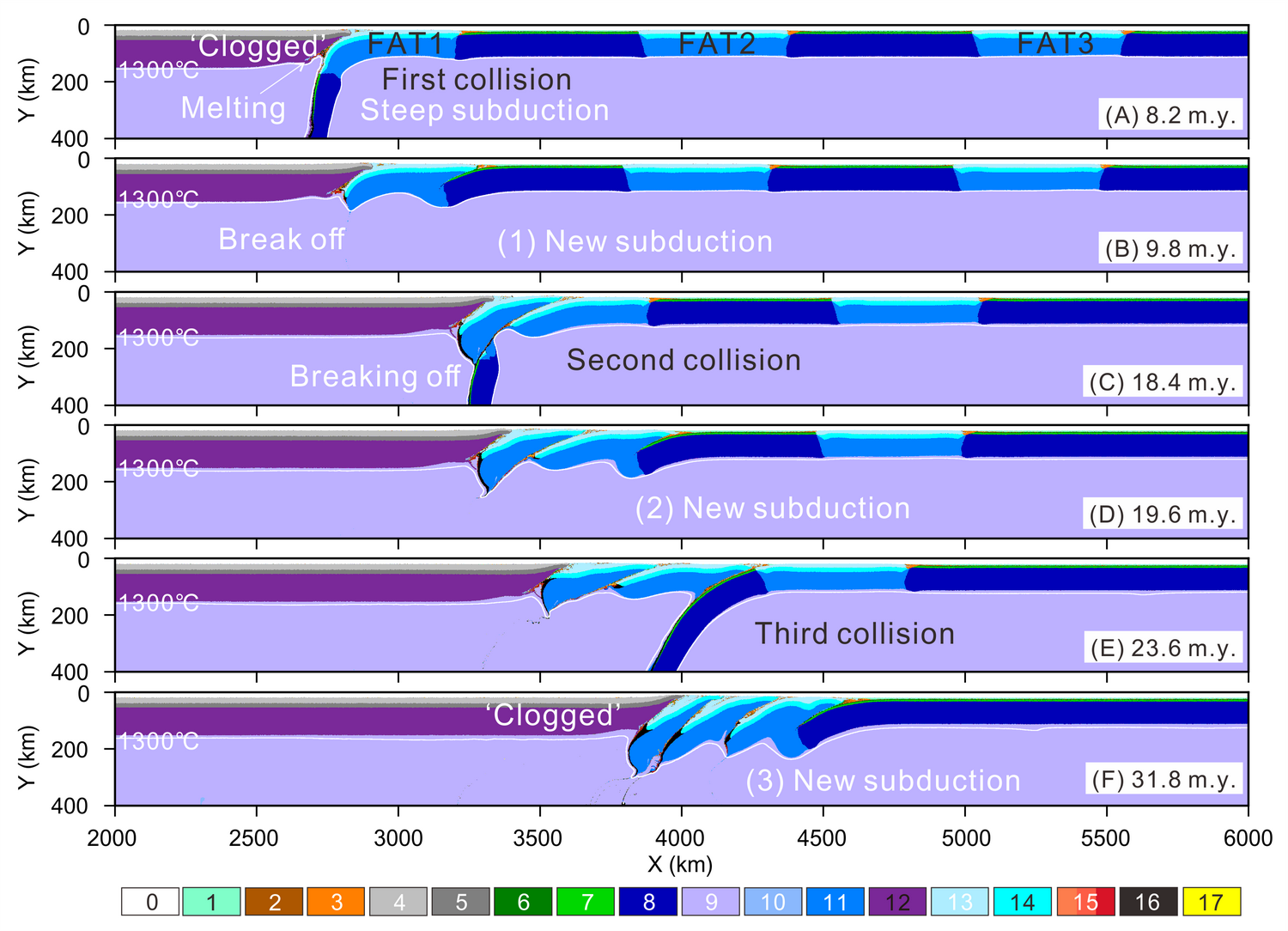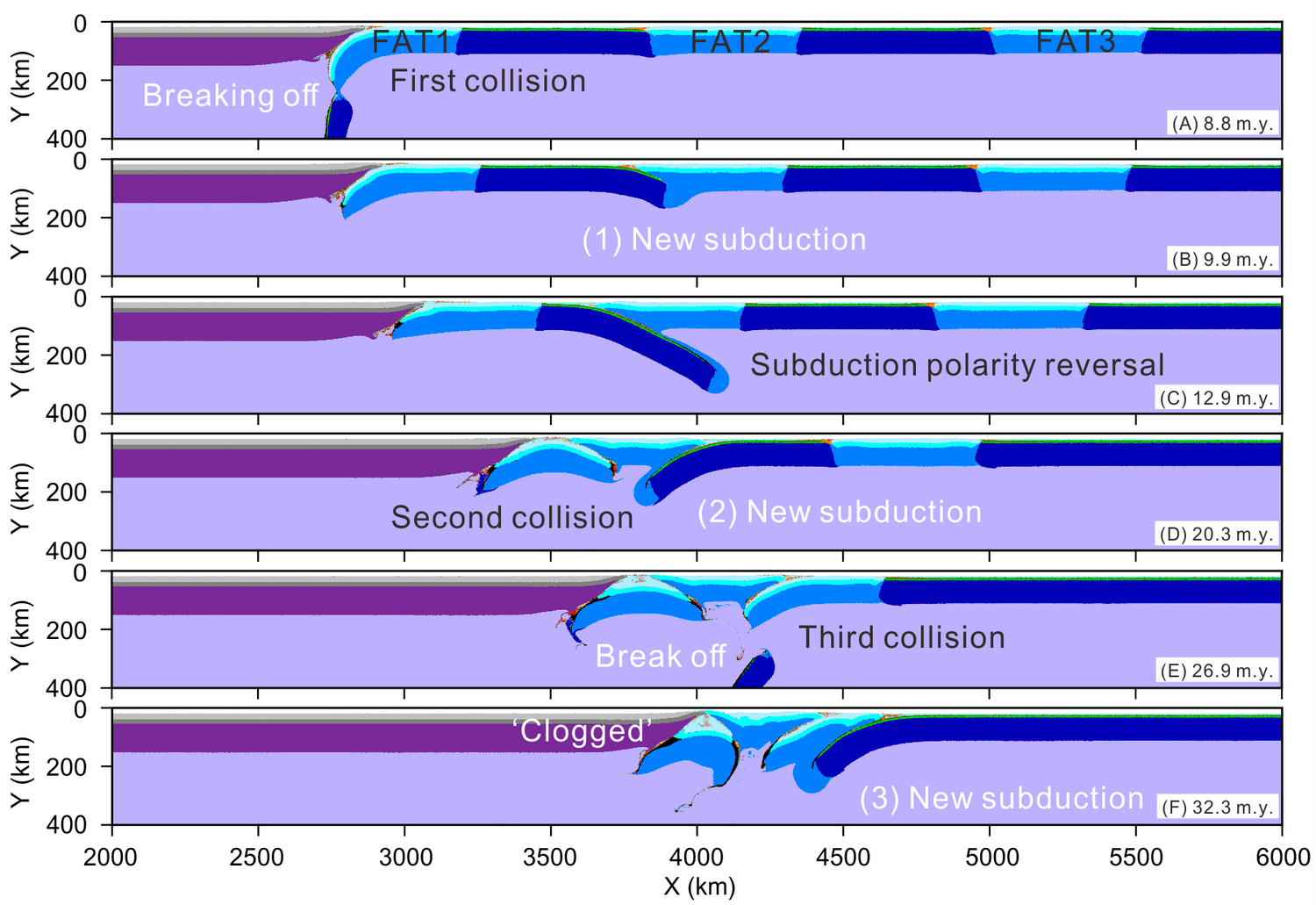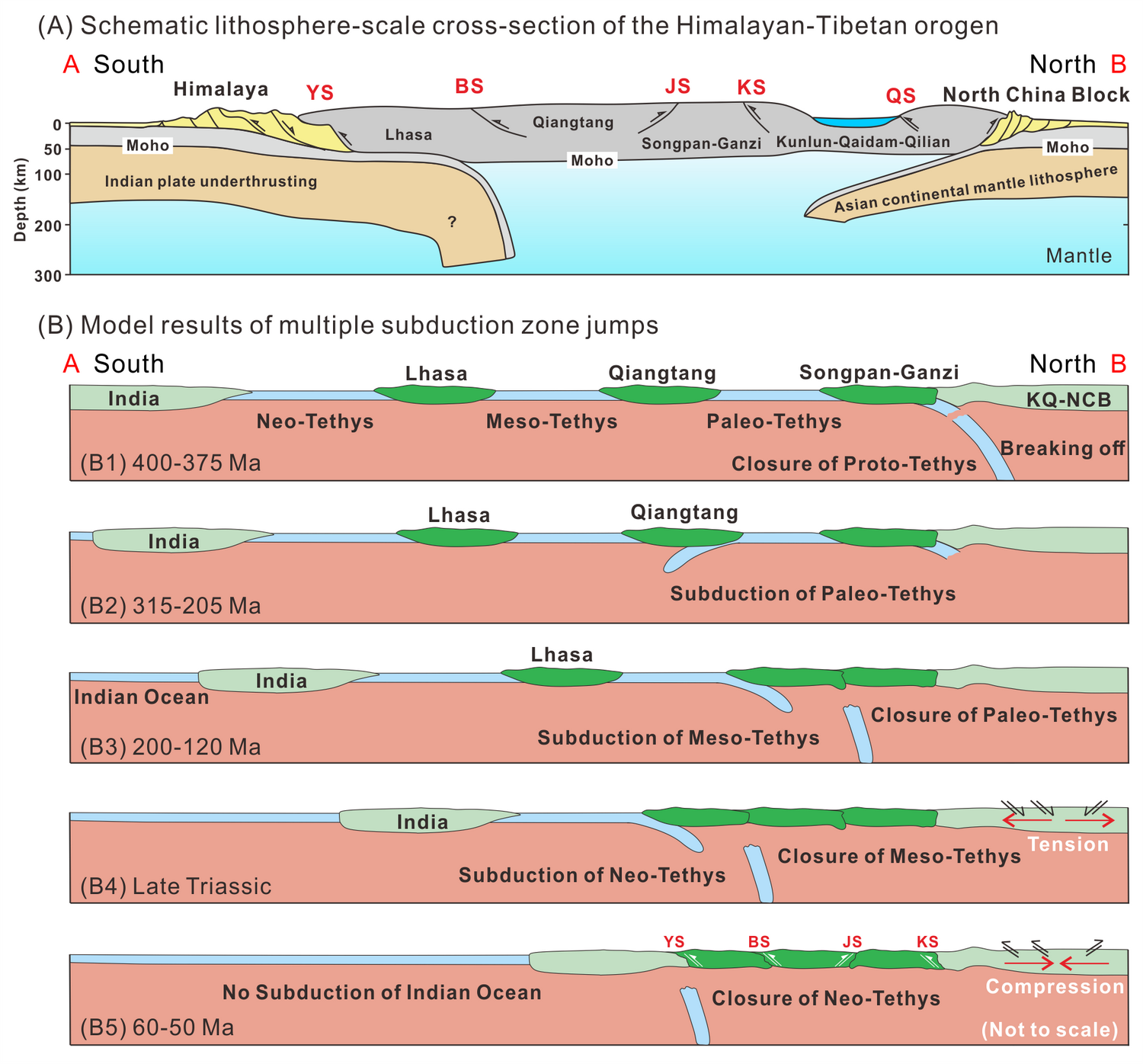The collision and amalgamation of continental or oceanic terranes have played a crucial role in Earth’s continental growth and the formation of supercontinents throughout history (Figure 1A). Subduction zones accommodate the convergence and eventual collision of these terranes. Post-collision terranes resist self-subduction, necessitating phases of subduction initiation and subduction zone jumps for the continued process of multiple terrane accretions. Since the Paleozoic Era, several continental ribbons that separated from the Gondwana continent have collided with the southern margin of the Asian continent, leading to the closure of the Proto-, Paleo- and Neo-Tethys Oceans and the ongoing growth of the Asian continent. Thus, the Tethyan tectonic domain serves as a natural laboratory ideal for studying the general processes of multiple terranes accretion, subduction initiation, and subduction zone jumps (Fig. 1B, C).

Figure 1: (A) Tectonic evolution of terrane accretion and new subduction initiation. (B) Tectonic division of the Tethyan orogenic system across the Tibetan Plateau. (C) Schematic illustration of the evolution from the Proto-Tethys to the Neo-Tethys oceans.
Numerical modeling of these phenomena can provide essential insights, allowing comparisons with geological observations that constrain the timing and location of natural subduction zone jumps. Existing numerical models mostly focus on the collision of a single future allochthonous terrane and its accompanying single subduction zone jump process. However, the predicted time interval from collision to the onset of a new subduction is <10 million years (Myr), significantly shorter than the time span indicated by geological observations (~10-30 Myr). The dynamics of multiple terrane accretion events and the formation mechanisms of multiple subduction zone jumps, including the influence of sediments deposited around future allochthonous terranes, remain poorly understood. Geological and geophysical observations suggest that subducting sediments have weak friction and high pore fluid pressure, reducing interplate coupling forces influencing subduction rates. However, the impact of sediments surrounding future allochthonous terranes on multiple terrane accretion and subduction zone jumps remains unclear.
Addressing these scientific problems, Dr. YAN Zhiyong, Professors CHEN Lin, and MENG Qingren from the State Key Laboratory of Lithospheric Evolution of the IGGCAS, in collaboration with Associate Professor Andrew Zuza of the University of Nevada, Reno, used two-dimensional numerical simulations to explore the dynamics of continental accretion and subduction zone jumps caused by multiple terrane collisions. Model results were compared with relevant geological data from the Kunlun, Jinsha, Bangong, and Indus-Yarlung suture zones of central Asia. This study shows how sediments around the terranes and the structural complexity of overriding plates are crucial factors affecting the accretion of multiple plates and guiding subduction polarity. In all models, terranes exhibit unidirectional accretion at the continental margin. When thick sediments are located behind the terranes, the models show unidirectional subduction, indicating multiple subduction zone jumps (Fig. 2). The subduction jumping time (~3-20+ Myr) is primarily controlled by and inversely related to the complexity of previously collided terranes and convergence rates. When sediments are located in front of the terranes, the model results in subduction zones with varying polarity (Fig. 3). The study reveals that sediments play a crucial role in controlling where subduction will initiate, and accreted terranes deform and buffer stress build up, inducing subduction (Figure 3). In short, the lateral density and rheological differences around a future allochthonous terrane determine the location of a new subduction initiation.

Figure 2: The accretion of multiple terranes triggers multiple subduction zone jumps. This plot shows end-member Model 1 with sediments located at the rear of the terranes, resulting in consistent left-dipping subduction. Composition color codes: 0, stick air; 1, water; 2 and 3, sediments; 4 and 5, continental upper and lower crust, respectively; 6 and 7, oceanic upper and lower crust; 8, oceanic lithosphere; 9, asthenospheric mantle; 10, hydrated mantle; 11, future allochthonous terrane (FAT) lithosphere; 12, continental mantle; 13 and 14, FAT upper and lower crust; 15, partially molten oceanic/FAT crust and partially molten mantle; 16, eclogitization of oceanic/FAT crust; 17, serpentinized mantle.

Figure 3: The accretion of multiple terranes triggers subduction dipping in different directions. This plot shows end-member Model 2 with sediments located in front of the terranes and the resultant variable subduction polarity. The composition color codes are consistent with Figure 2.
The successive collision of terrenes, causing multiple subduction zone jumps, provides insight into key dynamic processes in the Tethys tectonic domain. Despite individual accretionary terranes in the Tethyan domain developing back-arc basins and southward subduction, the overall northward evolution trend of the Tethyan domain remains unchanged (Fig. 1). End-member Model 1 replicates the process of successive jumps in multiple subduction zones and the migration patterns of magmatism (Fig. 2). Furthermore, through a comparative analysis of the main suture zone characteristics of the Tethyan domain (Fig. 4A), the study finds that the evolution process of end-member Model 2 (Fig. 3) aligns well with the subduction polarity of these four sutures (Fig. 4). Additionally, the modeling results offer an explanation for the prolonged delay in subduction jump time. Slow plate convergence rates and previously formed composite terranes may play a crucial role in the delay in subduction initiation. For instance, neither the Indian continental margin nor the interior of the Indian Ocean have initiated subduction for >50 Myr after the India-Asia collision. This delay may result from slower plate convergence and the absorption of deformation by the Himalayan-Tibetan Plateau orogenic belt. This study predicts that the accumulation of sediments on the southern margin of India to a certain thickness and/or the action of far-field forces (ocean ridges or mantle plumes) will trigger the initiation of northward subduction of the Indian Ocean in the future.

Figure 4: (A) Schematic lithosphere-scale cross-section of the Himalayan-Tibetan orogen. (B) Model results of multiple subduction zone jumps. Abbreviations: YS, Yalu suture. BS, Bangong suture. JS, Jinsha suture. KS, Kunlun suture. QS, Qilian suture. KQ-NCB, Kunlun-Qaidam-North China block.
This study uses numerical simulations to reproduce the dynamic process of successive accretion of multiple future allochthonous terranes and multiple subduction zone jumps. The model results contribute to the discussion on the evolution history of the Tethyan tectonic domain, providing an important framework for deeper understanding of Tethyan dynamics.
The research has been recently published in the journal Geological Society of America Bulletin (Zhiyong Yan, Lin Chen, Andrew V. Zuza, Qingren Meng. Successive accretions of future allochthonous terranes and multiple subduction zone jumps: Implications for Tethyan evolution. GSA Bulletin, 2024.). The study was funded by the National Natural Science Foundation of China (91955311, 42204099) and the National Science Foundation of the United States (EAR 1914501, 2210074).
Contact:
CHEN Lin
State Key Laboratory of Lithospheric Evolution
E-mail: chenlin@mail.iggcas.ac.cn